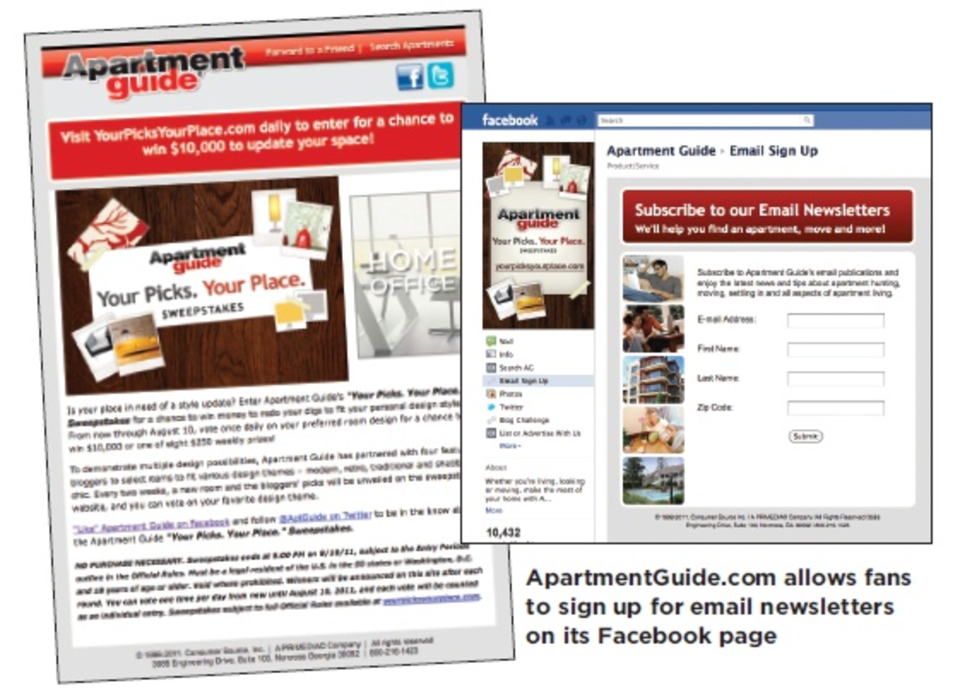Social media gets lots of buzz in marketing circles, but most marketers will admit that they haven’t been able to monetize the channel. However, some savvy marketers are experimenting with how to use social media as an email acquisition channel, since email is known for its strong ROI. ?
ApartmentGuide.com has found that using Facebook as an email acquisition tool attracts its most engaged users. It created an app that it hosts on its Facebook page where consumers can sign up for email newsletters. ?
“The people that we have had subscribe to our email newsletters from our Facebook page are extremely engaged. Their open rates and click-through rates are much higher than people who sign up through our website,” says Jason Amann, senior marketing manager at Primedia, the company that owns ApartmentGuide.com. “Facebook stands out from other channels of acquisition for email.”?
Amann says the two channels go hand-in-hand. ApartmentGuide.com sends newsletters with editorial content such as “How to find an apartment” or “How to move with pets,” and repopulates its Facebook page with similar content.?
By integrating email capture tools on a Facebook page, marketers can create a presence in the social world and tie it to a channel with more opportunities to drive sales. “It is an affordable means to capture email subscribers that are brand advocates, raising the potential that these consumers will share your email content on Face-book,” says David Daniels, CEO of The Relevancy Group. ?
According to a May 2011 survey by The Relevancy Group, 55% of marketers stated that they have fan pages on Facebook, but only 41% of those with branded fan pages are attempting to collect email addresses on them. “While marketers are easily seduced by the potential of social marketing, they are failing to connect it to email, which is unfortunate since email is the most profitable marketing tool that marketers have,” adds Daniels.?
For Kraft Foods, using social media is an effective way to introduce a product. But rather than just make a Facebook page for MiO, its new line of water-flavor enhancements, the company used its page to run a promotion that included an email element. It invited consumers to try a free sample in exchange for their email and mailing addresses. The first 100,000 people to “like” the page got a free sample of the product before it hit the shelves in March. Consumers who signed up were given the option to share the campaign on their own Facebook pages.?
“If you have a constant tab on your Facebook page to collect email add-resses, people have to go and find it,” says Elisa Kleniewski, senior account manager at e-Dialog. “If you run a promotion in which you collect email addresses, that tends to work best. There is value in the promotion.”?
Is asking a consumer to sign up for social media and email overkill? Experts across the email industry agree this is not the case. “A consumer is very willing to engage with a brand on multiple channels, as long as you offer value,” says Dan McDermott, marketing communications manager at e-Dialog. “A consumer’s attention is divided, and it’s not going more in one direction or another, so marketers should be in all of these channels.”?
Jim Belosic, CEO of ShortStack, a company that works with email service providers to help them embed email list capture into Facebook, also points out that just because a consumer likes a brand on Facebook doesn’t mean he is seeing every message that it posts.?
“Brands think that just because they have a thousand fans, all of those people will be exposed to their status updates, but the reality is that only about 10% of your fan base actually sees each update,” he says. “That is why email marketing is still important, so that you get your message out to people who are interested but may not see your status updates.”







